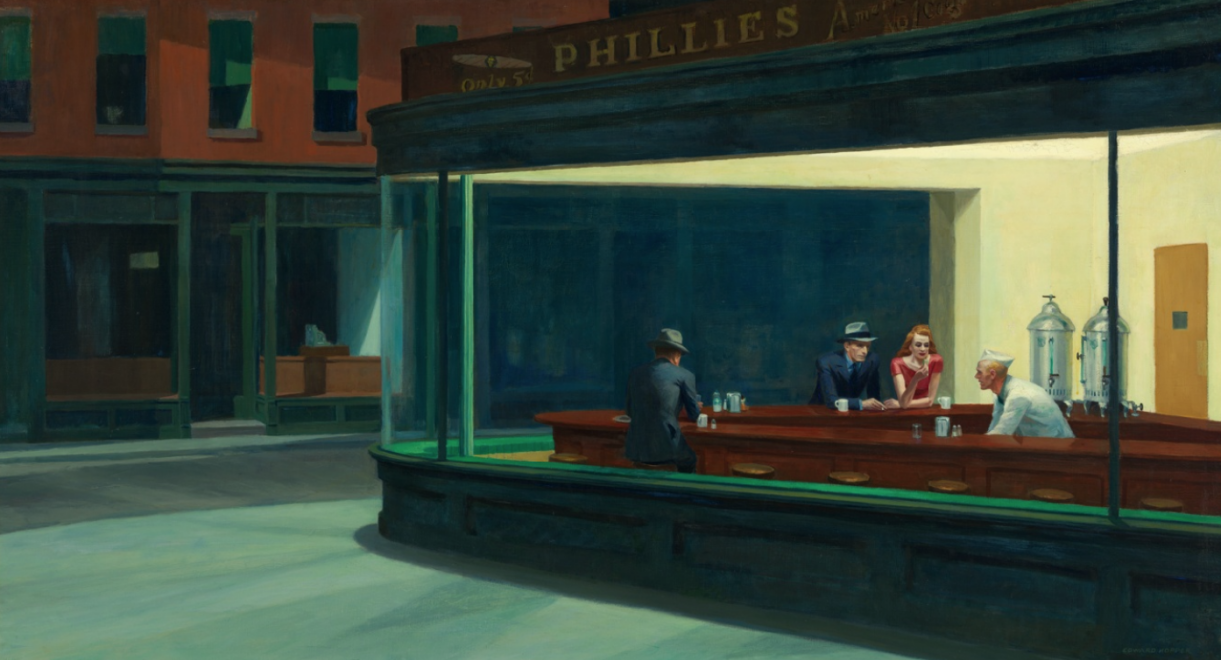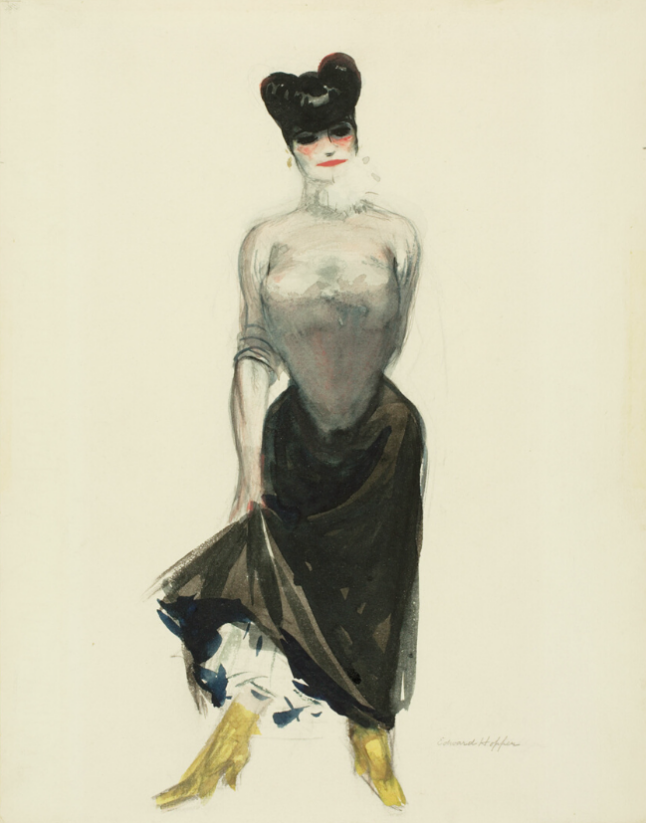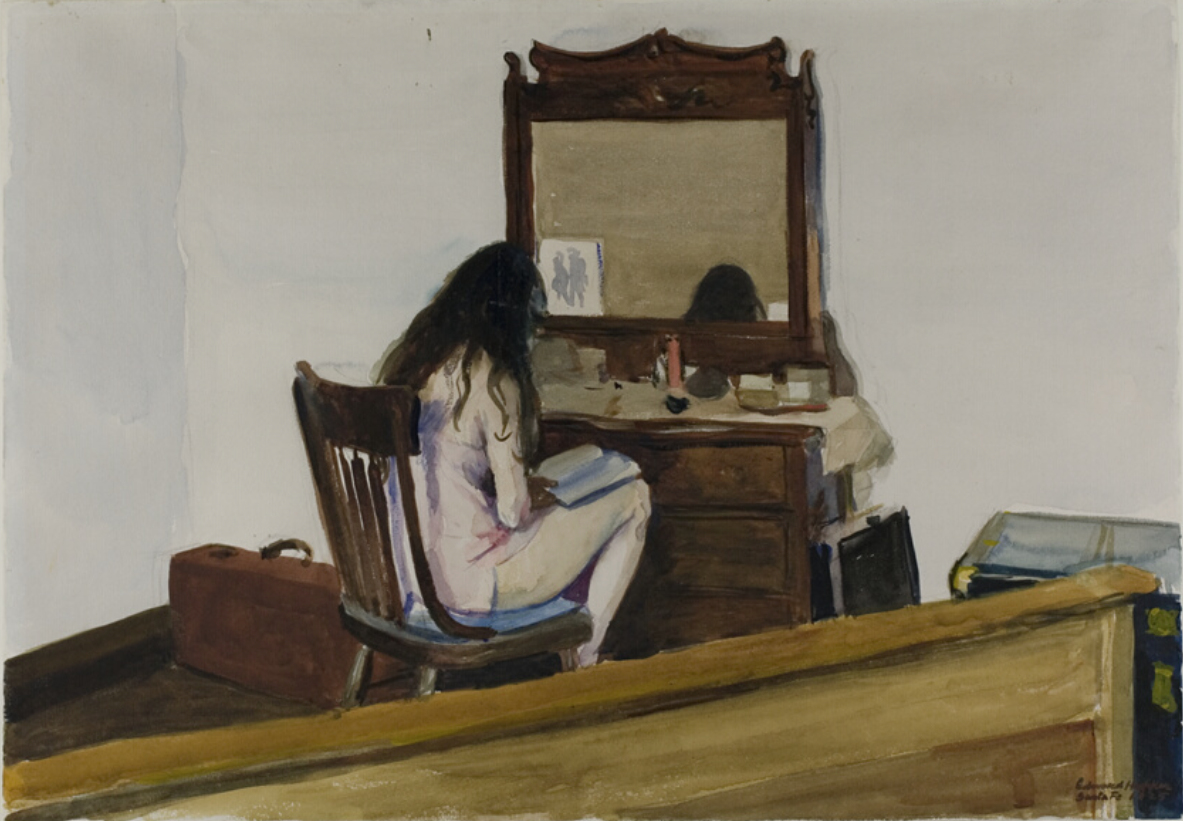I remember when I first saw Edward Hopper’s paintings, I thought it was contemporary art since it differed drastically from my understanding of traditional American school. The colors and shapes were so memorable, and each artwork told a unique story that most ordinary people could understand. I was particularly fascinated with the painter’s approach to art and its resemblance to real life. Perhaps, it was also due to the fact that I could never immerse myself in the paintings of civil war or the depiction of the Great Depression since these topics were always so distant for me. However, Hopper portrayed real life that I was immediately attracted to and felt a close connection to the unique stories depicted in the art. Recently, I have visited the Art Institute of Chicago and remembered my first impression of Hopper’s art as I walked through the museum. The artwork that I saw – Nighthawks (1942, Appendix A) – spoke to me on a personal level and ignited a feeling of comfort rather than loneliness. I am not entirely certain of the reasons, but the scene of the man sitting alone in the 1940s diner ignited some nostalgic experience that I never had in my life. During my trip, I have also thoroughly enjoyed Streetwalker (1906, Appendix B) and Interior (1925, Appendix C), that invoked similar feelings of nostalgic loneliness associated with a certain degree of comfort. In this essay, I will share my experience with Hopper’s art and attempt to analyze the paintings and their impact on my perception of art.
As I later learned, Nighthawks is Hopper’s most famous work that depicts a man and a couple sitting in the 1940s diner. There are no people outside of the restaurant, which implies a late night with the only source of light coming from fluorescent lights, creating a sense of security in the diner. However, my personal feelings and experience with Hopper’s Nighthawks contradict the author’s initial message. According to Hopper, the artwork conveys a sense of loneliness, albeit the author admitted that it was an unintentional connotation. He even states, “unconsciously, probably, I was painting the loneliness of a large city” (“Nighthawks, 1942”). The formal elements of the painting, such as the emphasis on the diner and distribution of light, support this statement. Considering the context and date of the artwork, the whole American nation was disturbed by the Second World War, which further amplifies the sense of dread and loneliness. Furthermore, the viewers do not see the face of the lonely man, which might be perceived as a technique to dehumanize the characters and shift the focus to their feelings. The whole scene invoked a sense of American solitude, which made the artwork famous globally. Nevertheless, personally, I primarily experience the nostalgic feeling of early 20th century American diners and a sense of comfort. The restaurant is the focal point of the artwork, and, in my opinion, it looks like a sanctuary in the late night in America during times of uncertainty and war. Nevertheless, this difference in perception between the original message and my point of view allows me to further appreciate the details of the artwork and immerse myself in Hopper’s depiction of real life.
The second artwork, Streetwalker (1906), is an excellent representation of American fashion at the turn of the century. The painting depicts a woman with a distinguishable clothing style, makeup, and hairstyle, invoking a sense of nostalgia for the unique period in American history. Similar to most of Hopper’s artworks, Streetwalker is an ode to real life and ordinary people. Hopper was able to convey the message of realism and tell a unique story even with a simple portrait and a monotonous background. Nevertheless, the viewers are curious and ask themselves questions: Who is this woman? Where is she going? Is she getting ready for a party? The author was able to intrigue the viewers and create a narrative for the painting. Concerning formal elements, the striking contrast between the grayish color of the woman’s skirt with blouse and bright red makeup with emphasized yellow shoes further supports the narrative. The woman is evidently preparing for some event or party, but the modest top and bottom symbolize the relatively harsh historic period and peculiarities of American fashion at the time. Ultimately, Hopper demonstrated that even a seemingly simple portrait can immerse the viewers in the setting and convey the message of ordinary life.
Interior (1925) is another Hopper’s depiction of solitude; however, similar to Nighthawks, I would argue that Interior is also about a sense of comfort and personal security. The painting depicts a relatively messy room with a woman reading a book in front of a table and a mirror. The viewers cannot explicitly see the woman’s (or a girl’s?) face, and it is complicated to establish the person’s age. However, it is evident that she is immersed in the book with little attention to the outside world or her own appearance. In my opinion, it perfectly symbolizes how an individual can find comfort and safety in themselves without the assistance of other people. It further emphasizes the private setting of ordinary people with no need for pretense, where they can simply enjoy themselves by reading a book. Concerning the formal elements, the woman is definitely the focal point of the artwork. The surrounding furniture and unkempt room further emphasize the central figure and her activity. In the mirror, the viewers can only see a blob of messy black hair, which implies the woman’s brief disassociation from the outside world and focus on the book. Ultimately, I believe that Interior excellently conveys the message of ordinary people, who frequently merely want some alone time to indulge in their favorite hobbies.
Each of the three discussed paintings by Edward Hopper depicts the daily lives of ordinary people, representing the beauty of seemingly insignificant activities. Nighthawks tells a story of a diner in a period of uncertainty and how a typical restaurant might symbolize loneliness or sanctuary, depending on the perspective. Streetwalker depicts the ordinary lives of people at the turn of the century by demonstrating American fashion. Lastly, Interior is an ode to simple activities and hobbies that might help people escape from the outside world, albeit even if for a brief period. Hopper’s works are recognized as symbols of American solitude, and some people frequently associate it with loneliness or depression. However, as mentioned before, my experience with Hopper’s art is different. Looking at all three paintings, I get a sense of comfort and hope due to how beautiful ordinary life might be. Sitting at the diner at midnight or reading books for hours might seem like an insignificant piece of life, but I believe that such details make life fuller and more pleasant. From these considerations, I particularly enjoy Hopper’s art and can immerse myself in his paintings.
Appendix A

Appendix B

Appendix C

Works Cited
Hopper, Edward. Interior. 1925, Art Institute of Chicago.
Hopper, Edward. Nighthawks. 1942, Art Institute of Chicago.
Hopper, Edward. Streetwalker. 1906/1907, Art Institute of Chicago.
“Nighthawks, 1942 by Edward Hopper.” EdwardHopper, n.d.